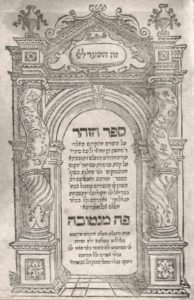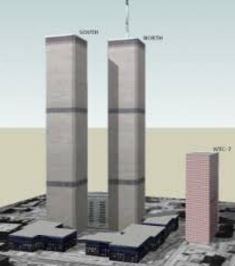Parashat Balak describes how the Moabite king Balak hired the (non-Jewish) prophet Bilaam to curse the Israelites. Balak saw what the Israelites had done to neighbouring kingdoms, and feared that he would lose his own as well. He therefore sought to reverse their fortunes through a curse. The Sages state that Bilaam could sense the precise moment when – just once a day, for precisely 1/58,888th of an hour (or about 61 milliseconds) – God was in his “strictest” mode, and Bilaam could take advantage of this moment to kindle God’s wrath against His chosen people (Berakhot 7a).
The plan ultimately failed, of course, and instead of cursing the Israelites, Bilaam’s mouth uttered blessings and praises. Perhaps most interesting, Bilaam also spoke a series of prophecies about the End of Days. They begin like this:
I see it, but not now; I behold it, but it is not soon. A star has gone forth from Jacob, and a scepter will arise from Israel which will smite the Moabite princes and uproot the sons of Seth. Edom shall be inherited, and Seir will become the inheritance of its enemies, and Israel shall do valiantly. And out of Jacob shall one have dominion, and will destroy the remnant of the city… (Numbers 24:17-19)

1558 Mantua Publication of the Zohar
Bilaam describes a time in the very distant future, and the Sages agree that the “star of Jacob” refers to Mashiach. The Zohar (III, 212b) further elaborates on Bilaam’s prophecies, and describes what precisely is supposed to happen, and when that star of Jacob will be seen. Within this lengthy passage are a few verses that describe a scene quite familiar to the modern reader, and have therefore been used to suggest that the Zohar predicted the events of September 11, 2001:
… And [the star] will be seen on the sixth day, on the 25th day of the sixth month. It will be gathered on the seventh day, at the end of seventy days. On the first day it will be seen in a city of Rome. On that same day, three high structures of that city of Rome will fall and a great edifice will fall…
In traditional Jewish texts, Rome is typically referred to as Edom, and represents the entire Western (or European/Christian) world. The “city of Rome” represents whatever place is the centre of the Western world at a particular period of time. After the city of Rome itself had fallen in 476 CE, the “new Rome” was Constantinople. When this new Rome collapsed as well (and became present-day Istanbul), a “Third Rome” was said to arise. In the past, we have written about the identity of the Third Rome. Most scholars – at least in Jewish circles – agree on two possibilities: the Third Rome is either Moscow (as we have written about before), or New York.*

World Trade Centers North, South, and 7
If it is indeed New York, then the Zoharic passage above makes a lot of sense. A great edifice of three high structures will fall? Yes, on September 11, three of the iconic World Trade Center buildings collapsed (WTC1, WTC2, and WTC7). And the dates match quite closely, too. The Zohar says the 25th of the sixth month, ie. the 25th of the month of Elul. September 11, 2001 happened to be the 23rd of Elul!
Shortly after the 9/11 attacks, a number of articles circulated online (for example, here) suggesting that the Zohar predicted this tragedy, and added an additional detail of great interest: These articles claimed that Rabbi Eliyahu Kramer, better known as the Vilna Gaon – who lived in the 18th century – corrected the Zohar and wrote that the event will, in fact, take place on the 23rd of Elul. These articles claim that the Vilna Gaon’s correction is recorded in a mystical text called Sifra DiTzniuta.
Are these claims true, and did the Zohar really predict the September 11 attacks?
What Do The Prophecies Actually Say?
First of all, Sifra DiTzniuta was written and published long before the Vilna Gaon’s time, so suggesting that his correction of the Zohar was recorded there is already unlikely. The Vilna Gaon did write a commentary to the Sifra DiTzniuta. Having searched through both Sifra DiTzniuta and the Vilna Gaon’s commentary on it, I was unable to find any reference to the 23rd of Elul, or any correction of the Zohar’s prophecy. This doesn’t necessarily mean the claim is false, but it definitely looks like the source is incorrect.
Either way, we have to go back to the Zohar and read the entire passage, not only those few verses describing the fall of the buildings. It reads like this:
It is taught that in the future, the Holy One, blessed be He, will rebuild Jerusalem and reveal one firm star, glowing with seventy pillars of fire, and with seventy sparks flashing from it in the middle of the Firmament, and they will be reigned over by seventy other stars, and they will glow and burn for seventy days.
And [the star] will be seen on the sixth day, on the 25th day of the sixth month. It will be gathered on the seventh day, at the end of seventy days. On the first day it will be seen in a city of Rome. On that same day, three high structures of that city of Rome will fall and a great edifice will fall. The ruler of that city will die. Then the star will spread out to be seen in the rest of the world. In that time, great wars will stir all around the four corners of the world and no faith will be found among [its people].
In the middle of the world, when that star will shine in the middle of the Firmament, a great king will arise and rule the world, and his spirit will gain pride over all the kings, and he will awaken a war between both sides, and he will become strong against them.
On the day that the star will be hidden, the Holy Land will tremble forty-five miles around the place of the Holy Temple, revealing an underground cave. From this cave will come out a blazing fire to burn the world. And from this cave a great branch will grow out, and it will rule over the whole world, and to it will be given the kingdom. The Holy Beings will gather to it. Then Mashiach will be revealed to the entire world…
Clearly, there is a lot more going on! While Jerusalem has been rebuilt, we have yet to see the emergence of a star glowing with seventy pillars of fire, with seventy other stars glowing for seventy days. (These may be metaphors, of course, and may not be literally referring to celestial objects.) The Zohar says the edifice would fall at the end of seventy days (or at the beginning, depending on how one reads the passage). There was nothing particularly salient about the period of seventy days before or after 9/11. Moreover, “the ruler of that city” did not die on that day. The events of 9/11 did instigate “great wars” and it is true that we live in an increasingly faithless world. Ultimately, a “great king” to rule the entire world has not arisen (as far as we can tell), nor did the Holy Land tremble to reveal a cave from which Mashiach sprang forth.
Therefore, to suggest that this Zohar is speaking of the 9/11 attacks is perhaps a bit premature. While there are several parallels, the entire sequence of events has not occurred in the years since September 11, 2001. It appears that we have yet to witness the true fulfilment of Bilaam’s and the Zohar’s prophecies.
—
*While New York is the largest city in the United States, and by far its most important and famous, another candidate for the “Third Rome” is Washington, D.C. Washington has the plus of being a capitol city, the seat of “the ruler” as the Zohar says. It, too, was attacked on 9/11, and its major edifice – the Pentagon (the world’s largest office building) – damaged. Interestingly, long before Washington became America’s capital city, it was settled by a man who named it Rome!
The article above is adapted from Garments of Light – 70 Illuminating Essays on the Weekly Torah Portion and Holidays. Click here to get the book!




